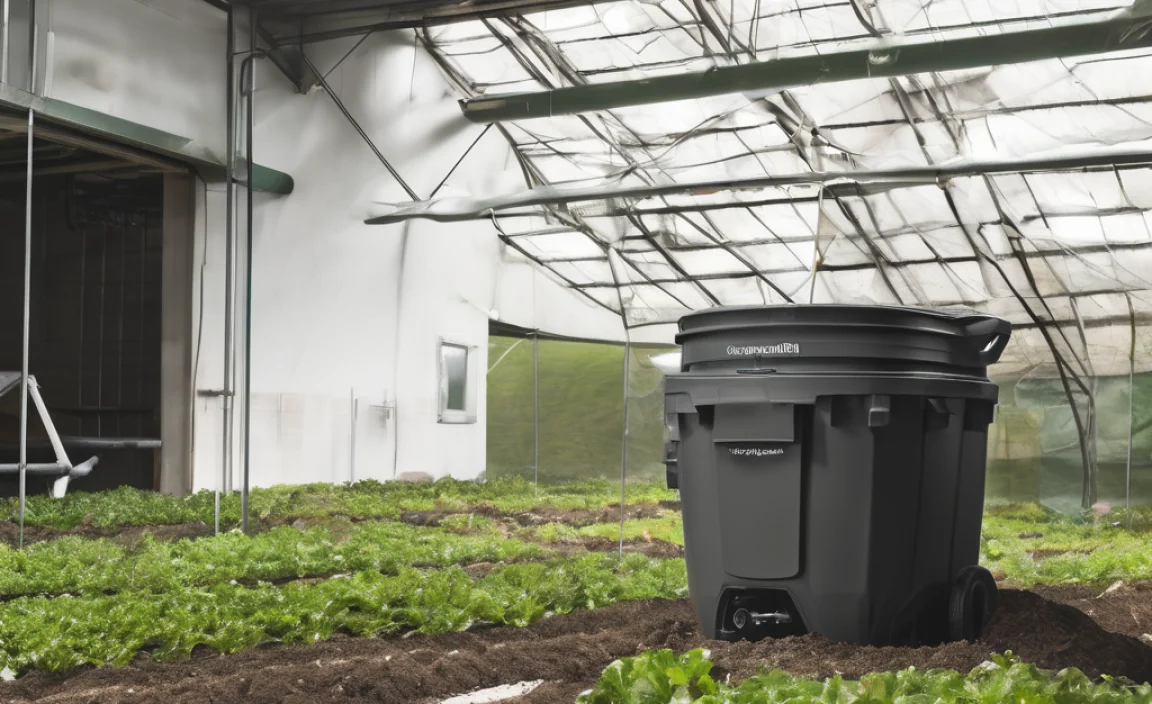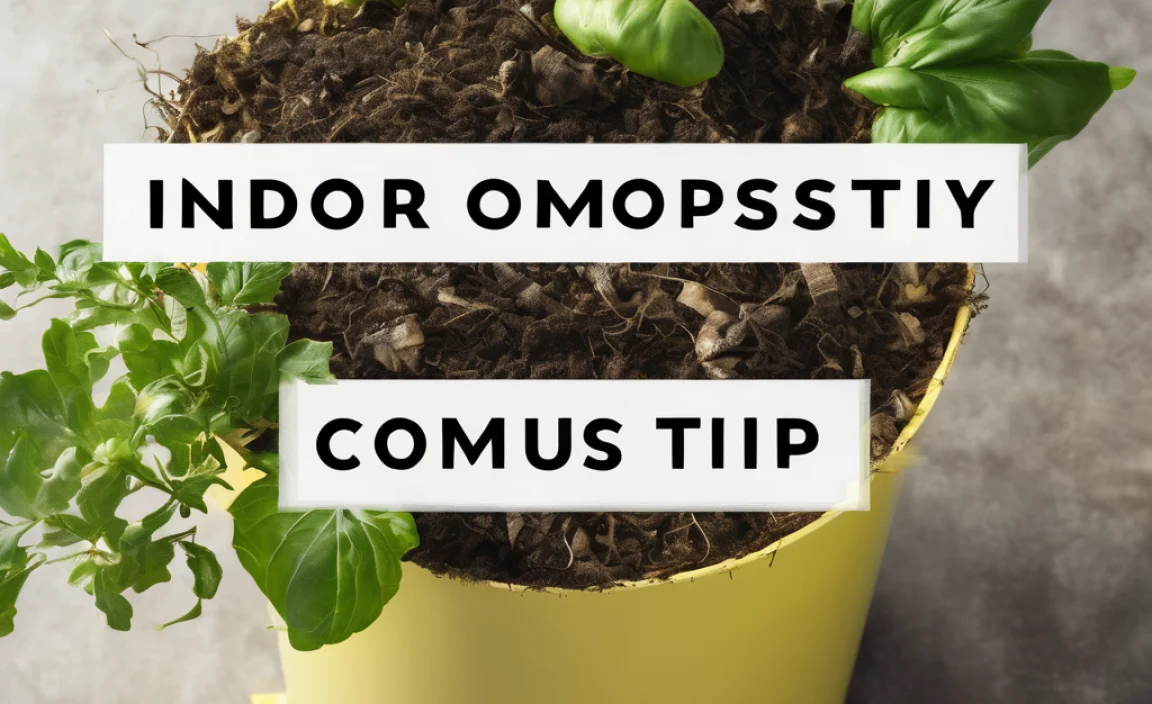Ever tossed food scraps into your compost bin, only to be met with a slow, sometimes smelly, process? You’re not alone! Many of us dream of rich, dark compost without the usual wait or worry. Hot composting speeds things up, but it can feel complicated and requires a lot of effort to get right. What if there was a simpler way?
Good news! There’s a fantastic alternative that gives you the benefits of quick composting with a lot less fuss. This method is perfect for beginners and busy folks. We’ll walk you through exactly what it is and how you can start using it today to turn your kitchen and yard waste into garden gold in no time.
Why Hot Composting Can Be Tricky (and What to Look For in an Alternative)
Hot composting, often called “thermo-composting,” is like giving your compost pile a supercharged boost. It relies on getting the balance of green (nitrogen-rich) and brown (carbon-rich) materials just right, plus keeping the pile moist and aerated. When done perfectly, it can produce compost in as little as 4-6 weeks!
However, achieving those ideal conditions can be a challenge for many home composters. It often requires:
- Precise Carbon-to-Nitrogen Ratio: Getting this balance slightly off can halt the heating process.
- Frequent Turning: This is key for aeration but can be physically demanding.
- Ideal Moisture Levels: Too dry and it won’t heat up; too wet and it can become anaerobic (stinky!).
- Sufficient Volume: A pile needs to be at least 3x3x3 feet to effectively build up heat.
For beginners or those with less space and time, these requirements can feel like a lot. That’s where a great hot composting alternative shines. We’re looking for a method that:
- Is easier to manage.
- Requires less physical effort.
- Works well in smaller spaces.
- Produces compost relatively quickly.
- Minimizes common composting problems like odors and pests.
The Genius Hot Composting Alternative: Bokashi Composting
The brilliant hot composting alternative we’re talking about is Bokashi. You might have heard of it, and if you haven’t, get ready to be impressed! Bokashi isn’t technically composting in the traditional sense because it doesn’t involve decomposition through heat and aerobic microbes. Instead, it’s a fermentation process done anaerobically (without oxygen) using a special Bokashi bran inoculated with effective microorganisms (EMs).
Think of it like making sauerkraut for your food scraps! It pre-treats your waste, breaking it down and making it more digestible for the soil. The end result is a nutrient-rich, fermented material that can be buried in your garden or added to a traditional compost pile to finish decomposing much faster.
How Bokashi Works: The Science Made Simple
At its core, Bokashi uses specific strains of lactic acid bacteria and other EMs. When you mix your kitchen scraps with the Bokashi bran, these microbes get to work. They consume the sugars and starches in your food waste, producing lactic acid. This acid lowers the pH and pickles the waste, preventing the growth of harmful bacteria and fungi that cause rotting and odors.
Because it’s anaerobic, you don’t need to turn it, and it doesn’t produce the foul smells associated with decomposing organic matter. It works on ALL food scraps, including meat, dairy, and oils, which are often problematic in traditional composting systems.
What is Bokashi Bran?
Bokashi bran is a carrier material (like wheat bran or sawdust) that has been fermented with a mix of beneficial microorganisms. These EMs are the “workers” that start the fermentation process in your Bokashi bin. You can buy Bokashi bran online or at some gardening supply stores, or you can even make your own if you’re feeling ambitious (though buying is simpler for beginners).
The Bokashi Bin: Your Fermentation Station
A Bokashi bin is essentially an airtight container with a spigot at the bottom. This spigot is crucial because the fermentation process releases a liquid called “Bokashi tea.” This tea is a potent liquid fertilizer, packed with nutrients. The airtight nature of the bin is what keeps oxygen out, allowing the anaerobic fermentation to occur. You can buy dedicated Bokashi bins, or you can use two airtight buckets, drilling a hole for a spigot in one.
Getting Started with Bokashi: A Breeze for Beginners
Starting Bokashi composting is incredibly straightforward. You don’t need a large garden space, and the upfront setup is minimal. Here’s what you’ll need and how to do it:
What You’ll Need
- Bokashi Bin: One or two airtight bins with a spigot.
- Bokashi Bran: Enough to sprinkle on your food scraps.
- Kitchen Scraps: All types of food waste, including meat, dairy, bones, and oils.
- Tool for Chopping (Optional but Recommended): A knife or small food processor to chop scraps into smaller pieces.
Step-by-Step Bokashi Process
It’s really as simple as this:
- Add Scraps: Place your kitchen scraps into the Bokashi bin. Chop larger items into smaller pieces (about edible bite-size) to help the fermentation process. This isn’t strictly necessary but speeds things up.
- Sprinkle Bran: Sprinkle a tablespoon or two of Bokashi bran evenly over the scraps. You want a light dusting. Make sure the scraps are well-coated.
- Compact: Press down on the scraps to remove as much air as possible. This is key to keeping the process anaerobic.
- Seal: Close the lid tightly. The bin should be airtight.
- Repeat: Continue adding scraps, sprinkling bran, and compacting until the bin is about two-thirds to three-quarters full.
- Ferment: Once the bin is full enough, seal it tightly and let it sit for at least 2 weeks in a warm, dark place. Avoid opening it during this time.
- Drain Tea: Regularly (every 2-3 days) drain any liquid that collects at the bottom by opening the spigot. This “Bokashi tea” is a fantastic liquid fertilizer! Dilute it with water (1:100 ratio) before using it on plants or pour it directly onto your garden soil or down the drain to help clean it.
- Bury or Finish: After the 2-week fermentation, you’ll have pickled, slightly fermented food waste. You can no longer eat it, but it’s not yet compost. You have two main options:
- Bury it: Dig a trench or hole in your garden about 6-8 inches deep and 12 inches away from plant roots. Bury the fermented Bokashi material, cover it with soil, and wait another 2-4 weeks for it to fully break down into rich soil. This is the quickest way to get it into your garden.
- Add to Compost Pile: Add the fermented material to your existing hot compost pile or worm bin. It will break down much faster there because it’s already been pre-treated.
The Magic of Bokashi Tea: Your New Favorite Fertilizer
Don’t underestimate the power of Bokashi tea! This liquid is a byproduct of the fermentation process and is packed with nutrients and beneficial microbes. It’s the liquid gold of Bokashi. When diluted, it’s an excellent plant food that can boost growth and health in your garden, houseplants, or even on your lawn. Some people even use the undiluted tea to help clear clogged drains or as a natural septic system additive, as the microbes can help break down waste.
University Extension services often highlight the benefits of compost teas, and Bokashi tea is a type of biological enhancer for your soil.
Pros and Cons: Is Bokashi Right for You?
Every method has its ups and downs. Bokashi offers some fantastic advantages, especially as a hot composting alternative.
| Pros | Cons |
|---|---|
| Handles all food scraps (meat, dairy, bones, oils). | Requires purchasing Bokashi bran and a specialized bin. |
| No unpleasant odors during fermentation. | The fermented material needs further breakdown (burying or adding to compost). |
| Produces nutrient-rich Bokashi tea fertilizer. | Small amount of liquid byproduct needs to be drained regularly. |
| Fast pre-treatment of waste (only 2 weeks). | Requires some space for the bin, even if small. |
| Can be done indoors or in small spaces (apartments, balconies). | The end product is fermented, not finished compost, until buried or added to a compost pile. |
| Reduces landfill waste effectively. | Some users find the initial smell of the fermented product a bit strong before burying. |
| Simple, hands-off process once the bin is full. | Requires a second fermentation/decomposition stage. |
Bokashi vs. Traditional “Hot” Composting: A Quick Comparison
Let’s break down how Bokashi stacks up against traditional hot composting. Knowing the differences helps you pick the best method for your needs.
| Feature | Bokashi | Hot Composting |
|---|---|---|
| Process Type | Anaerobic Fermentation | Aerobic Decomposition (Heat-driven) |
| What You Can Compost | All food scraps (incl. meat, dairy, oils) | Primarily fruit/veg scraps, yard waste; meat/dairy usually avoided |
| Pest/Odor Issues | Minimal to none during fermentation | Can attract pests; potential for odors if not managed well |
| Space Required | Small bin, can be done indoors | Larger pile (min 3x3x3 ft) usually outdoors |

I am passionate about home engineering. I specialize in designing, installing, and maintaining heating, ventilation, and air conditioning systems. My goal is to help people stay comfortable in their homes all year long.


